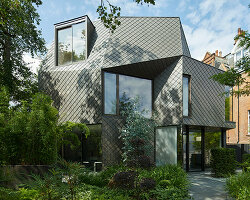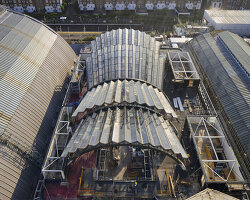in september 2016, the united kingdom launched an international design competition for a national memorial and learning center to honor the victims and survivors of the holocaust. ‘envisaged as a place for everyone to come to remember the holocaust, as well as a focal point for annual national commemorations, the memorial will affirm the united kingdom’s commitment to stand up against prejudice and hatred,’ says the competition’s organizers. the memorial will be located in london, alongside the houses of parliament and adjacent to the river thames.
now, 10 schemes — from creatives such as david adjaye, daniel libeskind, and anish kapoor — have been unveiled, and will be presented to the public before a winner is chosen in summer 2017. see each of the proposals, with thoughts from their designers, below.

entry from: anish kapoor and zaha hadid architects (also main image) | image by slashcube
all images and videos courtesy of malcolm reading consultants
anish kapoor and zaha hadid architects (with sophie walker studio, arup lighting, event london, lord cultural resources, max fordham, michael hadi associates, gardiner & theobald, whybrow, access=design and goddard consulting): meteorites, mountains and stones are often at the center of places of reflection, especially in the jewish tradition. they call on the vastness of nature to be a witness to our humanity. a memorial to the holocaust must be contemplative and silent, such that it evokes our empathy. it must be a promise to future generations that this terrible chapter in human history can never occur again.
entry from: anish kapoor and zaha hadid architects
the concept of our proposal is based on the understanding that a strong simple gesture has a strong visual and cognitive impact. our proposal for the holocaust memorial sits as a strong singularity – an identifiable image – that allows people to focus on the immensity of the message being conveyed. the grove of cypress appropriately stands as a sombre witness to these moments within the park symbolizing life, growth and hope in the face of adversity. the learning centre sits wholly below ground – a simple and humble receptacle to a rich content. the moral purpose of this project raises it beyond that of an established architectural style. the combination of the singular statement of the memorial and the humility of the learning center creates a strong partnership and defines the architectural quality of the proposal.

entry from: adjaye associates and ron arad architects
adjaye associates and ron arad architects (with gustafson porter + bowman, plan A and DHA designs): we have approached the national holocaust memorial and learning center as an opportunity to unearth the complexity of the holocaust story, which we see as a series of layers that have become hidden by time. our proposal aims to reveal these layers not through a static symbol commemorating the past, but through an organic living monument that evolves over time, capable of both affecting and being affected by its users.
entry from: adjaye associates and ron arad architects
our design integrates learning center, memorial and landscape into a multifaceted holistic sensorial and emotive journey. through a careful sequencing of highly immersive spaces that intentionally juxtapose moments of solitary engagement with moments of collective gathering, our design envelops the visitor in the physical, intellectual and emotional experience of the holocaust trauma. in so doing, we have resisted traditional notions of dictation in favor of encouraging visitors to draw personal meaning and purpose out of tragedy.

entry from: allied works
allied works (with robert montgomery, the olin studio, ralph appelbaum associates, allied info works, arup, curl la tourelle head architecture, PFB construction management services ltd, buro happold and nathaniel lichfield & partners): we stand at a moment of transition — a time when those who lived through the holocaust and witnessed the atrocities first-hand will no longer be present to provide testimony. our proposal for the memorial is not an object, but the creation of a sacred space to serve the voices of survivors. it rises from the grounds of victoria tower gardens, woven into the daily life of london.
entry from: allied works
folding back like a prayer shawl, it holds visitors in an embrace with the spoken word while framing a view to parliament, underlining our shared accountability. marked with a poet’s blessing, the memorial and learning center provide a place where all may come to hear the voice of our shared humanity and be inspired to take action against those who would deny it. it is a place to gather, listen, learn and remember — a space for britain and the entire world.

entry from: caruso st john architects, marcus taylor and rachel whiteread
caruso st john architects, marcus taylor and rachel whiteread (with vogt landscape architects, arup lighting and david bonnett associates): the catastrophic events of the holocaust took place outside the UK and the mass graves, remnants of atrocity and concentration camps that are found in mainland europe do not exist on british soil. a memorial in london will not, therefore, commemorate a particular place, but instead it can embrace a universal theme and foreground the first-hand testimony of survivors.
entry from: caruso st john architects, marcus taylor and rachel whiteread
caruso st john, marcus taylor and rachel whiteread’s proposal consists of two parts – a cast, translucent sculpture above ground and a series of large chambers below ground. the sculpture brings natural light into the largest and most memorable of these spaces — the ‘hall of voices’ — where visitors will hear the accounts of holocaust survivors and discover directly the network of lives, places and emotional bonds that were destroyed.
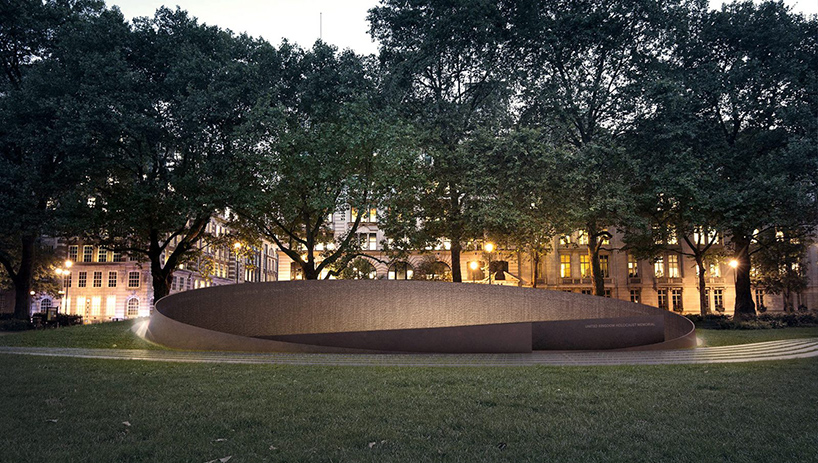
entry from: diamond schmitt architects
diamond schmitt architects (with ralph appelbaum associates, martha schwartz partners and arup): the subtlety of the design of the UKHM gradually reveals the power of the opposing forces that created the descent into a horror of hitherto unimaginable scale, and a humanity of unlimited compassion and selfless commitment. to create a memorial that is commensurate with its prominent site, and appropriate to content of such gravity, the architecture most suitable to serve the purposes of remembrance and caution against the repeat of intolerance, is one of restraint, yet notable form.
entry from: diamond schmitt architects
expressing the magnitude of the tragedy and the consequences of indifference to intolerance will have achieved the purposes of the UKHM and britain’s promise to remember. the inclusiveness of this memorial is also intended to rekindle hope for all those threatened, regardless of belief, ethnicity or gender, for it is manifestly clear that the bell tolls for all of us, even if at times it seems to toll only for others.

entry from: foster + partners and michal rovner
foster + partners and michal rovner (with simon schama, avner shalev, local projects, samantha heywood, david bonnett associates, tillotson design associates and whybrow): with minimum disturbance to the park, a ramp descends into the earth. evocative of train tracks that terminated in the camps or the brown brick lined corridors leading down to the gas chambers. this is the way to the time left memorial. projected images of an endless procession of human figures resonate with exodus or a human text that seems to go on forever like the unspoken testimonies.
entry from: foster + partners and michal rovner
the surface of the memorial is set in the landscape, a gently arched rusted steel plate on the cross axis of victoria tower, buxton memorial and st john’s smith square. the ramp entrance is marked by a sculpture of broken books evoking the burning of millions of books started by the nazis in 1933 with the words of heinrich heine ‘wherever they burn books they will in the end burn human beings’. marking the biggest break in the book of human history is also a reminder and a warning.
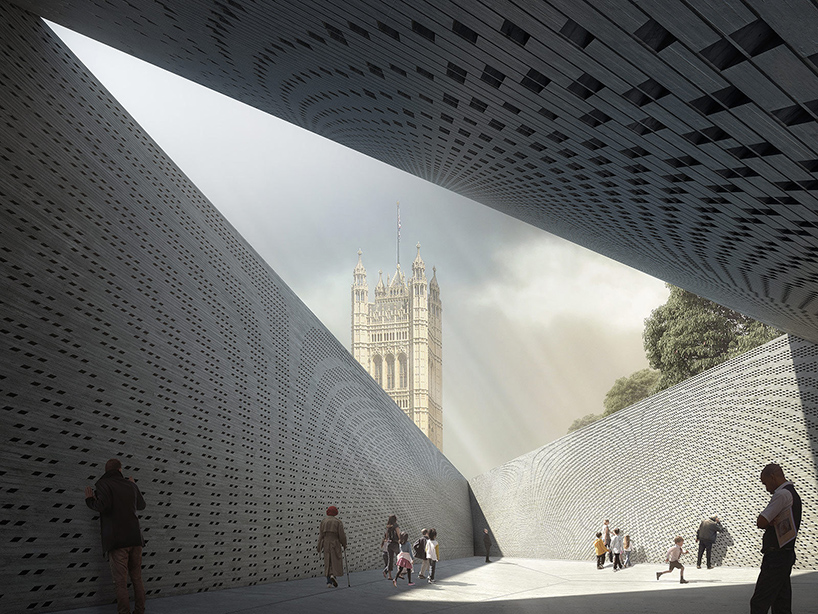
entry from: heneghan peng
heneghan peng (with gustafson porter + bowman, event, sven anderson, bartenbach, arup, bruce mau design, burohappold, mamou-mani, turner & townsend, PFB, andrew ingham & associates and LMNB): we are designing the memorial – learning center so that we never forget the holocaust. the memorial is an ear, that connects visitors with the voices and testimonies of those who experienced the holocaust. set within the individual voids that occupy the walls of the memorial, their sonic aggregate becomes the primary material of its sensory construction. visitors descend from the gardens through a series of thresholds and passages, encountering individual voices as they form a collective, of those who speak of past horrors and the grave risk of authoritarianism and barbarism returning today.
entry from: heneghan peng
rooted in british soil, these witnesses tell of their refuge and lives in freedom. the memorial courtyard – the ‘ear’ – is focused upwards to victoria tower, its view reminds the visitor of the democratic promise of britain’s parliament, its people and traditions. with the ascent to the tower comes a unifying sense of purpose in the value of free, tolerant societies and a collective desire to defend its principles. we build to remember.

entry from: john mcaslan + partners and MASS design group
john mcaslan + partners and MASS design group (with lily jencks studio, local projects and arup): in jewish tradition, the laying of a stone at a grave marks a visit by relatives, remembering the deceased. this simple act binds generations together. the word for ‘stone’ in hebrew – ןבא or eben – is a construct of א or aleph, (heavenly father) and ב or bet, (son) and so the word for stone symbolizes this continuity between generations.
entry from: john mcaslan + partners and MASS design group
the legacy of the holocaust – or shoah – is not just the elimination of nearly 6 million jews; but the grievous loss of generations that never came to be – millions of stones yet to be placed. thus the ritual of placing the stone signifies a way of establishing legacy over generations. the act of taking a stone symbolizes our individual and collective commitment to remembrance. this is our memorial proposal. 6 million stones placed at and then taken from the centre of london. eben.
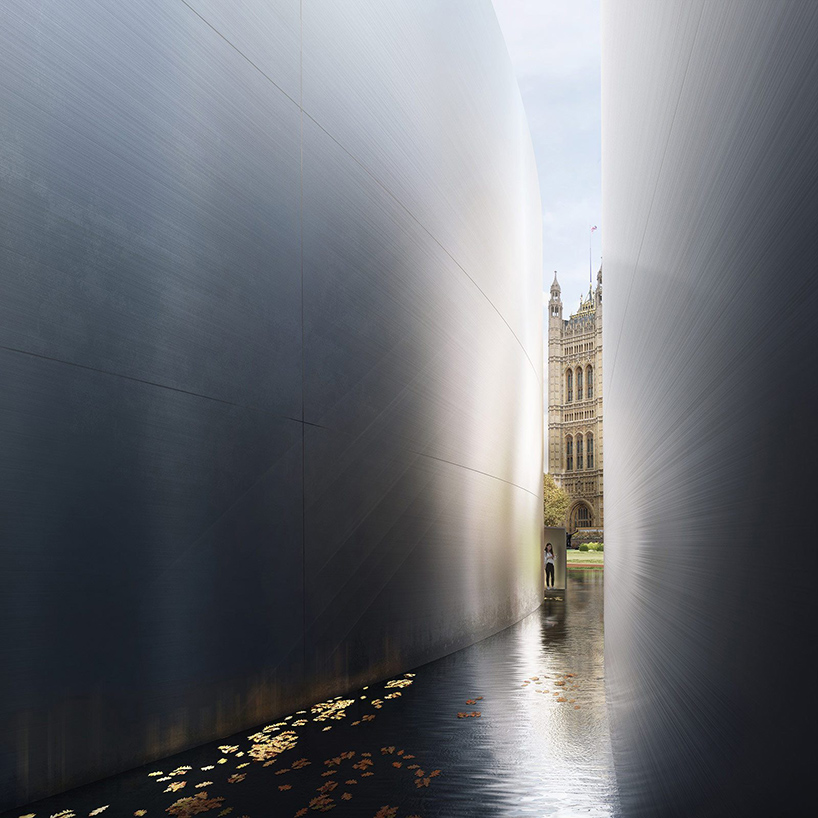
entry from: lahdelma & mahlamäki architects and david morley architects
lahdelma & mahlamäki architects and david morley architects (with ralph appelbaum associates, hemgård landscape design, barbara kirshenblatt-gimblett, dani karavan and arup): the UK holocaust memorial and learning center summarizes the holocaust, the persecution and systematic mass murder against not only the jews, but also against other minorities, that took place during the second world war. the learning center provides information and evidence as well as an emotional and narrative experience about the era of the holocaust. the memorial is a composition of two arcs facing each other and a water pool. the first arc describes the holocaust, the other describes how it was experienced in the UK.
entry from: lahdelma & mahlamäki architects and david morley architects
the visitor walks through the arcs – rust spaces – symbolically along the iron rail tracks. the destination is either a death camp or a train journey across the channel into the UK. the area between the arcs and the steel surface of the memorial creates a bare space of tranquillity. the rusty or acidified steel sheets in the outer surface of the memorial, the symbolic signs of ships and trains and the constant remembrance of home – they all refer to the tragedy of the holocaust. the structures extending from the memorial into the learning center together with other rusty steel and concrete surfaces make one functional, artistic and emotional entity.

entry from: studio libeskind and haptic architects
studio libeskind and haptic architects (with martha schwartz partners, burohappold, lord cultural resources, alan baxter, garbers & james and james e. young): the memorial communicates a shadow that has been cast forever on the history of civilization. since there is no redemptive meaning in the holocaust, visitors carry this shadow with them as they journey underground. a dark, reflective metal plane cuts into the sky. the visitor walks down a wide timber ramp, passing through this plane into the underground. once inside, the visitor descends into darkness along a continuous trajectory, the path illuminated by light cast from the contents of the exhibitions.
entry from: studio libeskind and haptic architects
within this darkness, there is a single track – the path of hope – which elevates the visitor back into the world, culminating in a platform pier overlooking the thames. turning back, the visitor sees the memorial framed by the context beyond. this memorial is minimal and uncompromising in its message: that to forget the holocaust is to imperil civilization. lest one forgets the horror, one will see it repeated.
Save
Save
Save
Save
Save
Save
Save
Save
Save
Save
Save
Save
Save
Save
architecture in london (251)
architecture in the UK (432)
PRODUCT LIBRARY
a diverse digital database that acts as a valuable guide in gaining insight and information about a product directly from the manufacturer, and serves as a rich reference point in developing a project or scheme.




